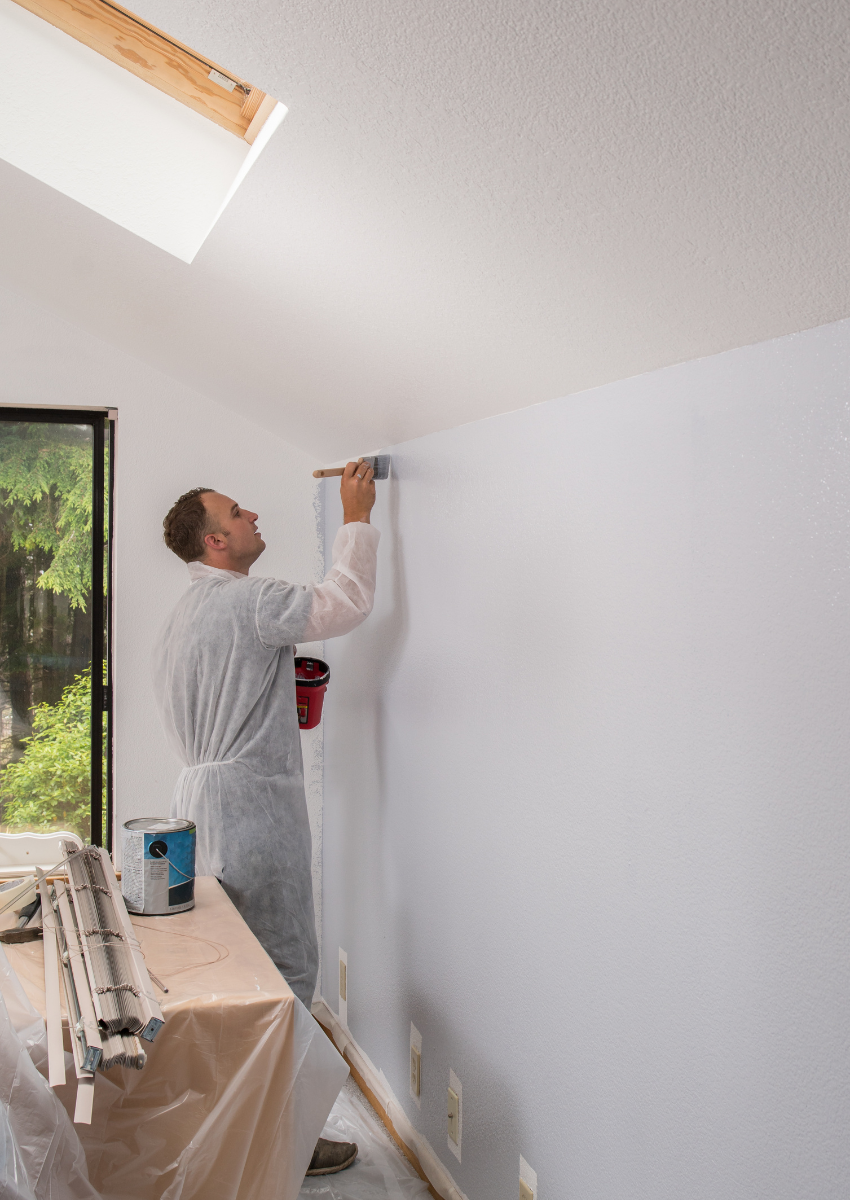Why is my paint peeling? Paint peeling can be a frustrating and common issue for homeowners. It doesn’t just look bad—it can also point to other underlying problems.
Especially in Thornton, CO, where humidity levels and temperature fluctuations are factors. You may notice signs like bubbling, cracking, or even chunks of paint coming off on walls and ceilings. This is an issue that can happen with any paint project, from residential homes to larger commercial spaces, and it often catches people off guard.
Why does paint peel so quickly?…. Well, it can stem from several causes, like poor prep work, moisture, incompatible paint, or too many layers built up over time.
Below, we’ll explain the primary reasons why your paint might be peeling and offer insights on how to address it on your next interior paint project. So, if you’re tired of touching up your walls or simply curious about how to avoid the issue, keep reading.
Key Takeaways:
- This blog explains why is my paint peeling, focusing on common causes.
- Causes of peeling paint include moisture issues, improper prep, and incompatible paint types.
- Learn solutions to fix peeling paint and preventive steps for long-lasting results.

Why Is My Paint Peeling? Common Causes on Walls and Ceilings
Peeling paint on walls and ceilings can be a frustrating eyesore that often points to bigger issues beneath the surface. From improper prep work to environmental factors, various causes can lead to paint peeling and chipping away. Here’s a look at some of the most common reasons this happens and how to address them.
⦿ Water Damage and Leaks
Water is a common enemy of paint, leading to blistering, bubbling, and peeling. Leaks, dampness, or even high humidity can interfere with paint’s ability to adhere properly. In areas like Arvada, CO, where seasonal humidity is high, water damage can creep up unexpectedly, making walls more prone to peeling.
⦿ Old Calcimine Paint from the Past
If your ceiling or wall has paint peeling off, it could be due to an old layer of calcimine paint (also known as “Kal-Kote“), which was often used decades ago. Regular paint simply doesn’t stick to calcimine without special prep, so applying fresh paint over it can lead to peeling almost immediately. If calcimine is the culprit, a new layer of calcimine paint might be the only way to keep your paint from peeling.
⦿ Paint Applied in Thick Layers
Sometimes, a “quick-fix” approach leads to layers of paint that are just too thick. The extra weight, especially on ceilings, can speed up paint deterioration. Thick layers often result from repeated touch-ups rather than a full repaint, causing the layers to start peeling off over time.
⦿ Humidity in the Air
Poorly ventilated rooms, particularly in regions with fluctuating humidity levels, create a perfect environment for paint to peel. Humid air can seep into walls, creating damp conditions beneath the paint surface, which can eventually cause peeling. Mold and mildew may even start forming if the dampness goes unchecked.
⦿ Inadequate Surface Preparation
One of the biggest culprits behind peeling paint is improper prep work. If the surface wasn’t cleaned, sanded, and primed before the paint went on, it’s only a matter of time before peeling begins. For long-lasting results, prep work is essential to make sure that each layer adheres properly.
⦿ Painting Over Dirt and Grime
Dust, grease, and grime don’t just make walls look dirty; they create a barrier that paint can’t adhere to. If you paint over dirty surfaces, the result is often bubbling or peeling paint shortly after the project is finished. Clean, smooth surfaces are a must for a quality paint project.
⦿ Heat and Direct Sunlight
Constant exposure to heat or sunlight can weaken the adhesive properties of paint. High temperatures cause paint to dry too quickly, weakening the bond between layers and causing peeling. If your walls or ceilings receive too much sunlight, they may be especially prone to cracking or peeling over time.
⦿ Different Paint Types on One Surface
Not all paints are compatible. If one coat is latex and the next is oil-based, or vice versa, these different types of interior paint won’t bond well, resulting in peeling. The same goes for primer—using an incompatible primer can ruin an otherwise solid paint project.
⦿ Low-Quality Paint Choices
Low-quality paint tends to be less flexible and lacks strong adhesive properties, which can lead to peeling. High-quality paint contains more pigment and resin, creating a more durable layer that’s less likely to peel.
⦿ Outdated Paint
Over time, paint can lose its adhesive properties. This is common with paint that’s been stored improperly or is simply old. If you notice an odd smell, a thickened texture, or clumps, it’s a good sign that the paint may be expired.
How to Tell If Your Paint is No Longer Usable
Knowing when paint has expired can save you the hassle of peeling or poor adhesion. Here are a few tips to check if your paint is still usable:
- Check for Film or Mold – A hardened layer or any sign of mold means the paint is likely expired.
- Check for Odors – Bad paint often has a sour or rotten egg smell.
- Test the Consistency – Stir it up! If the texture remains clumpy or uneven, it’s best to replace it.

Fixing Peeling Paint Issues: Steps You Can Take
Here’s a quick guide on common peeling areas on ceilings and walls.
Ceiling Peeling Fix:
- Scrape off peeling paint entirely.
- Patch the area and let it dry thoroughly.
- Apply a high-quality primer, preferably oil-based.
- Finish with a fresh, even coat of acrylic paint.
Wall Peeling Fix on Drywall:
- Remove all loose paint with a scraper.
- Sand the surface until it’s smooth.
- Patch any damaged spots with joint compound, then sand again.
- Apply a primer designed for drywall.
- Add two coats of paint for an even finish.
A protective top coat can prevent peeling for durable, long-lasting paint jobs. Some options include a polyurethane or polyacrylic coating, while waxes or other pastes can offer extra protection. Each material provides a shield that prevents chips and peeling. Here’s a guide on how to apply multiple coats of paint.
Final Thoughts
So, why is my paint peeling? Peeling paint can be frustrating, especially after investing time and money into a fresh coat. With quality products, proper prep work, and mindful application, you can avoid many of these common issues.
American Painting Specialists proudly serves Denver, CO and surrounding areas, bringing decades of experience and expert care to every painting project. We’ll help you achieve a seamless, professional finish that lasts.
Starting with a free consultation, we’ll guide you through each step, from surface preparation to the final topcoat, so you don’t have to worry about peeling paint again.
Call us at 720-343-4351 for a FREE estimate today and enjoy peace of mind with long-lasting, quality results.



